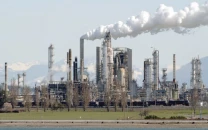Relief, flood reconstruction spur steel revival
Analysts caution recovery is not export-led, may pressure external account

After years of subdued activity and margin pressures, Pakistan's long-steel sector is expected to stage a gradual recovery from FY26 onwards, buoyed by government relief measures, federal spending on infrastructure, lower raw material duties and, to some extent, reconstruction-led demand in the wake of devastating floods.
However, this recovery is not export-led or efficiency-driven. Instead of enhancing competitiveness in global markets, it may add pressure to the country's external account, since higher domestic demand for long steel will inevitably increase imports of raw materials such as steel scrap and semi-finished products, as happened around 2015.
For the past several years, the long-steel industry has remained under strain due to weak demand, high financing and energy costs, and macroeconomic headwinds. The sector's performance at the Pakistan Stock Exchange (PSX) has also lagged broader indices. However, analysts at Taurus Securities now see signs of a turnaround, citing policy incentives, improved construction prospects, and cost rationalisation.
The federal budget FY26 has provided significant relief for long-steel manufacturers. Customs duties on key inputs such as steel scrap and semi-finished products have been slashed. Additional customs duty on steel scrap has been cut from 2% to 0%, while duty on melting scrap has been reduced from 3% to 0%. Moreover, customs duty on semi-finished products like billets has been halved from 11% to 5%, making conversion into rebar more cost-effective.
In addition, the government has announced a Rs5 billion mark-up subsidy to stimulate construction, along with tax credits on mortgage payments and incentives for low-cost housing projects. Such measures are expected to drive housing demand, particularly among the middle class, which now comprises around 5060% of the population. At the same time, the government has imposed sales tax on FATA/PATA regions, ending exemptions that undocumented players previously exploited. Sales tax will gradually rise from 10% in FY26 to 16% in FY29, creating a more level playing field for documented suppliers.
The recent floods across Punjab and Sindh are anticipated to create substantial demand for construction materials. Unlike FY23, when post-flood reconstruction failed to translate into higher cement and steel volumes due to poor economic conditions, analysts expect the current macroeconomic stability and fiscal support to enable a stronger response, according to a report prepared by Mustafa Mustansir and Asad Qureshi at Taurus Securities. National Public Sector Development Programme (PSDP) allocation for FY26 has been set at Rs4.2 trillion, with significant resources earmarked for infrastructure projects. Analysts believe this, coupled with rehabilitation works in flood-affected areas, will boost demand for long-steel products, especially rebar.
Since FY17, Pakistan has maintained high anti-dumping duties on finished steel imports such as rebar and wire rods. Effective protection rates surged to 123% in FY25, shielding domestic players but hurting exports. Under the new National Tariff Policy, the government plans to rationalise duties over the next five years, reducing the effective protection rate to 50-60%. This shift is intended to promote export competitiveness rather than import substitution, aligning with the broader goal of export-led growth.
Among listed companies, Mughal Iron & Steel (MUGHAL) stands out with a positive outlook. The company is set to benefit from budgetary duty reliefs, mark-up subsidies, and flood reconstruction demand, particularly in Punjab. Mughal's 36.5MW captive hybrid power plant is also scheduled for commissioning in 2QFY26, which will reduce energy costs by nearly 20% and support margins. On the other hand, Amreli Steels Ltd (ASTL) faces material uncertainty due to weak demand, loan covenant breaches, and suspension of SITE Rolling Mill operations, which accounts for 30% of capacity. The company is negotiating a debt restructuring plan and exploring asset sales to shore up liquidity.
Agha Steel Industries (AGHA) is also recovering from financial covenant breaches after a fire incident in 2023. Management is negotiating a restructuring agreement with lenders, which would unlock Rs385 million in insurance claims. With production restored and funds injected by sponsors, AGHA expects progress on its Mi.Da project, which could support long-term growth.




















COMMENTS
Comments are moderated and generally will be posted if they are on-topic and not abusive.
For more information, please see our Comments FAQ